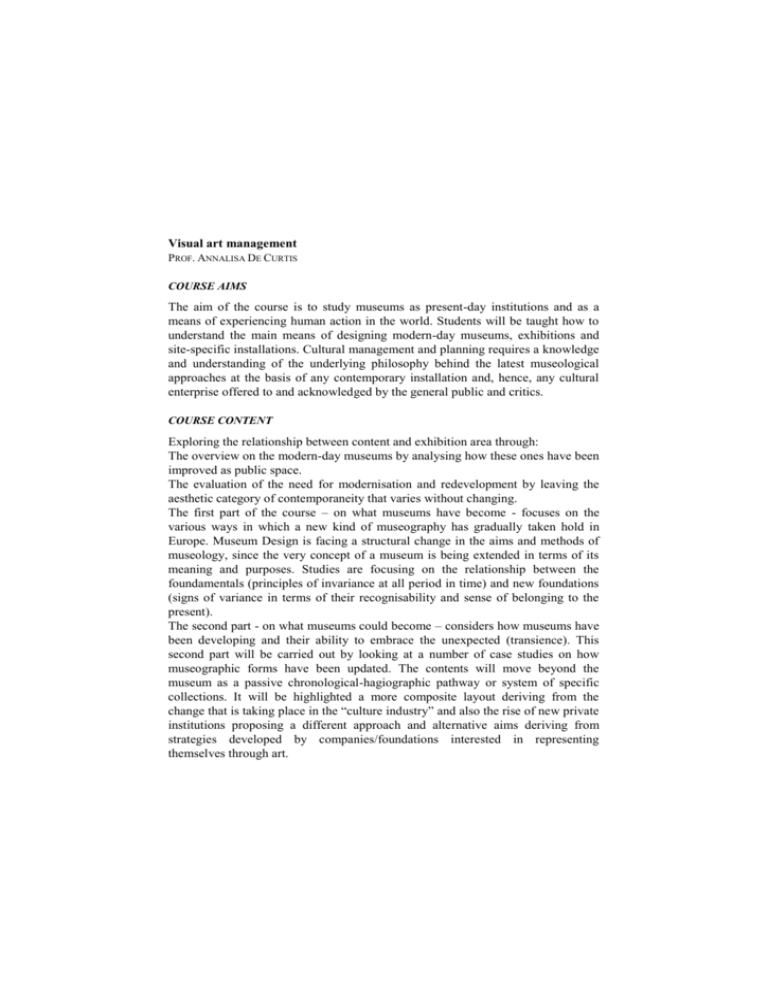Visual art management
advertisement

Visual art management PROF. ANNALISA DE CURTIS COURSE AIMS The aim of the course is to study museums as present-day institutions and as a means of experiencing human action in the world. Students will be taught how to understand the main means of designing modern-day museums, exhibitions and site-specific installations. Cultural management and planning requires a knowledge and understanding of the underlying philosophy behind the latest museological approaches at the basis of any contemporary installation and, hence, any cultural enterprise offered to and acknowledged by the general public and critics. COURSE CONTENT Exploring the relationship between content and exhibition area through: The overview on the modern-day museums by analysing how these ones have been improved as public space. The evaluation of the need for modernisation and redevelopment by leaving the aesthetic category of contemporaneity that varies without changing. The first part of the course – on what museums have become - focuses on the various ways in which a new kind of museography has gradually taken hold in Europe. Museum Design is facing a structural change in the aims and methods of museology, since the very concept of a museum is being extended in terms of its meaning and purposes. Studies are focusing on the relationship between the foundamentals (principles of invariance at all period in time) and new foundations (signs of variance in terms of their recognisability and sense of belonging to the present). The second part - on what museums could become – considers how museums have been developing and their ability to embrace the unexpected (transience). This second part will be carried out by looking at a number of case studies on how museographic forms have been updated. The contents will move beyond the museum as a passive chronological-hagiographic pathway or system of specific collections. It will be highlighted a more composite layout deriving from the change that is taking place in the “culture industry” and also the rise of new private institutions proposing a different approach and alternative aims deriving from strategies developed by companies/foundations interested in representing themselves through art. Thus, there are new museological layouts and museographic forms, which derive from the need to pay testimony to historical events of great ethical and civil significance. This approach will introduce new languages and opportunities. For this reasons, the third part of the course sets out to complete the overview of case studies by reflecting on the standardisation of the relations between recollectionmemory-history-the present by visiting a museum facility in Milan that is currently being completed. READING LIST G. AGAMBEN, Che cos’è il contemporaneo?, Nottetempo, Roma, 2008 V. NEWHOUSE, Towards a New Museum, The Monacelli Press, New York, 1998. J. PUTNAM, Art and Artifact. The Museum as Medium, Thames and Hudson, London, 2009. K. MCSHINE, The Museum as Muse: Artists Reflect, MoMA-Harry N. Abrams, New York, 1999. M. AUGÈ, Rovine e macerie. Il senso del tempo, Bollati Boringhieri, Torino, 2003. U. RIVA, Memoriale della Shoah Milano. Né un abbandono, né un commento in “Abitare”, n. 530, marzo 2013, pp. 62-73. A. DE CURTIS-G. MORPURGO, Il Memoriale della Shoah di Milano: infrastruttura tra documento e progetto, in C. COZZA-I. VALENTE (edited by), La freccia del tempo. Ricerche e progetti di architettura delle infrastrutture, Pearson Italia, Milano-Torino, 2014, pp. 68-74. S. SURIANO, La testimonianza dell’invisibile. Il Memoriale della Shoah di Milano, in “Engramma– Architetture per la memoria”, n.123, gennaio 2015. TEACHING METHOD Key words: lectures, conversations, discussion of case studies …. The first part of the course will be taught in lectures; the second part will consist of a discussion of selected case studies and, finally, a trip to a new museum facility in Milan currently being completed, followed by an on-site seminar. ASSESSMENT METHOD Continuous assessment in two successive stages. The first stage, a seminar during which students will be asked to create a manifesto for a museum, supplementing their own thoughts with specific topics studied at lectures and other planned activities. They will hand in a concise report (2 pages) to the lecturer summarising the main subjects they have examined. The second stage, the final individual examination, will consist of a discussion of the subject matter of the lectures, the intermediate seminar and reading list.




